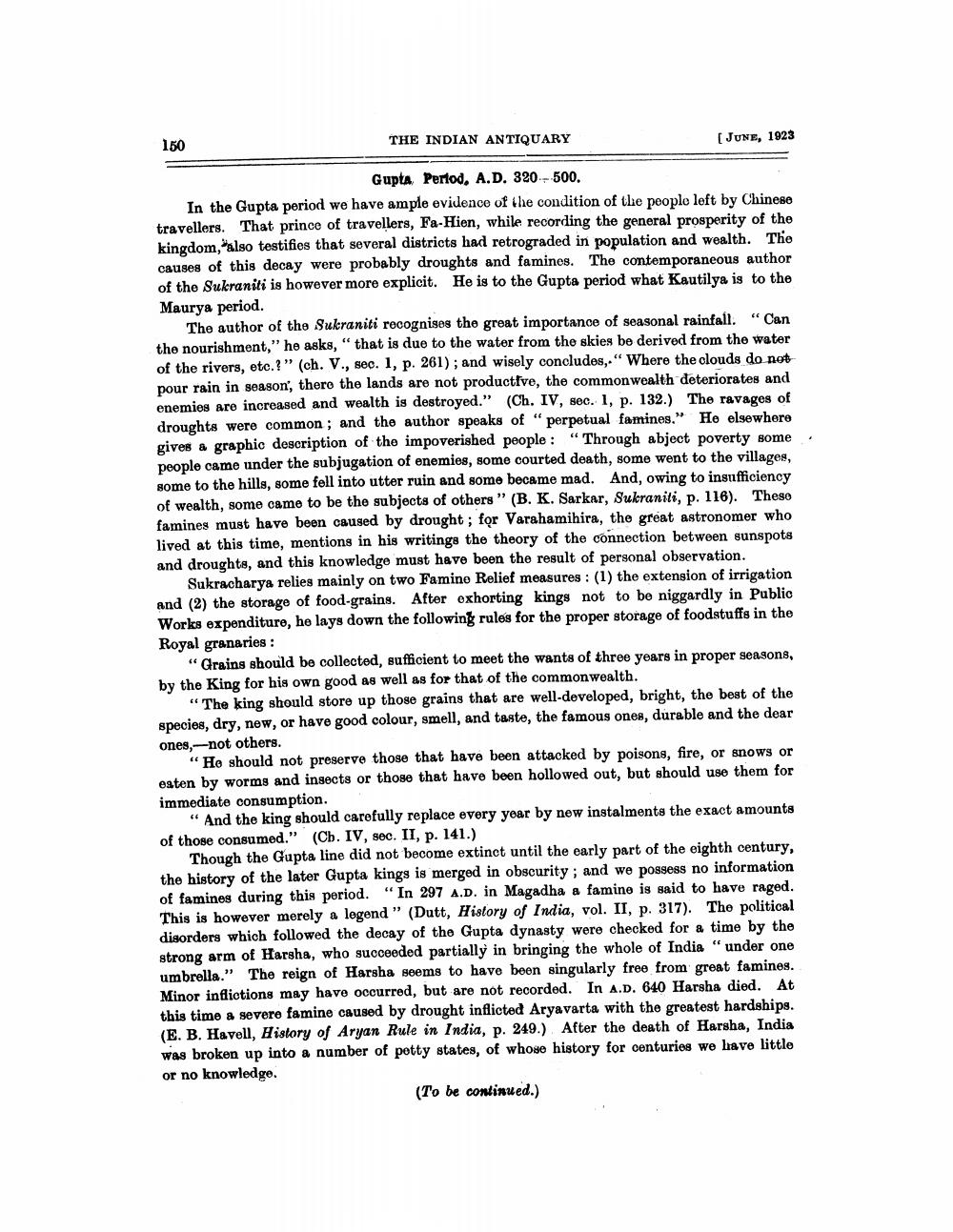________________
150
THE INDIAN ANTIQUARY
[JUNE, 1923
Gupta Period, A.D. 320 - 500. In the Gupta period we have ample evidence of the condition of the people left by Chinese travellers. That prince of travellers, Fa-Hien, while recording the general prosperity of the kingdom, "algo testifies that several districts had retrograded in population and wealth. The causes of this decay were probably droughts and famines. The contemporaneous author of the Sukraniti is however more explicit. He is to the Gupta period what Kautilya is to the Maurya period.
The author of the Sukraniti recognises the great importance of seasonal rainfall. "Can the nourishment," he asks," that is due to the water from the skies be derived from the water of the rivers, etc.?" (ch. V., sec. 1, p. 261); and wisely concludes,." Where the clouds do not pour rain in season, thero the lands are not productive, the commonwealth deteriorates and enemies are increased and wealth is destroyed.” (Ch. IV, Sec. I, p. 132.) The ravages of droughts were common; and the author speaks of "perpetual famines." He elsewhere gives a graphic description of the impoverished people: “Through abject poverty some people came under the subjugation of enemies, some courted death, some went to the villages, some to the hills, some fell into utter ruin and some became mad. And, owing to insufficiency of wealth, some came to be the subjects of others" (B. K. Sarkar, Sukraniti, p. 116). These famines must have been caused by drought; for Varahamihira, the great astronomer who lived at this time, mentions in his writings the theory of the connection between sunspots and droughts, and this knowledge must have been the result of personal observation.
Sukracharya relies mainly on two Famine Relief measures : (1) the extension of irrigation and (2) the storage of food-grains. After exhorting kings not to be niggardly in Public Works expenditure, he lays down the following rules for the proper storage of foodstuffs in the Royal granaries :
“Grains should be collected, sufficient to meet the wants of three years in proper seasons, by the King for his own good as well as for that of the commonwealth.
“The king should store up those grains that are well-developed, bright, the best of the species, dry, new, or have good colour, smell, and taste, the famous ones, durable and the dear ones - not others.
“He should not preserve those that have been attacked by poisons, fire, or snows or eaten by worms and insects or those that have been hollowed out, but should use them for immediate consumption.
"And the king should carefully replace every year by new instalments the exact amounts of those consumed." (Cb. IV, sec. II, p. 141.)
Though the Gupta line did not become extinct until the early part of the eighth century, the history of the later Gupta kings is merged in obscurity; and we possess no information of famines during this period. “In 297 A.D. in Magadha a famine is said to have raged. This is however merely a legend" (Dutt, History of India, vol. II, p. 317). The political disorders which followed the decay of the Gupta dynasty were checked for a time by the strong arm of Harsha, who succeeded partially in bringing the whole of India "under one umbrella." The reign of Harsha seems to have been singularly free from great famines. Minor inflictions may have occurred, but are not recorded. In A.D. 640 Harsha died. At this time a severe famine caused by drought inflicted Aryavarta with the greatest hardships. (E. B. Havell, History of Aryan Rule in India, p. 249.). After the death of Harsha, India was broken up into a number of potty states, of whose history for oenturies we have little or no knowledge.
(To be continued.)




